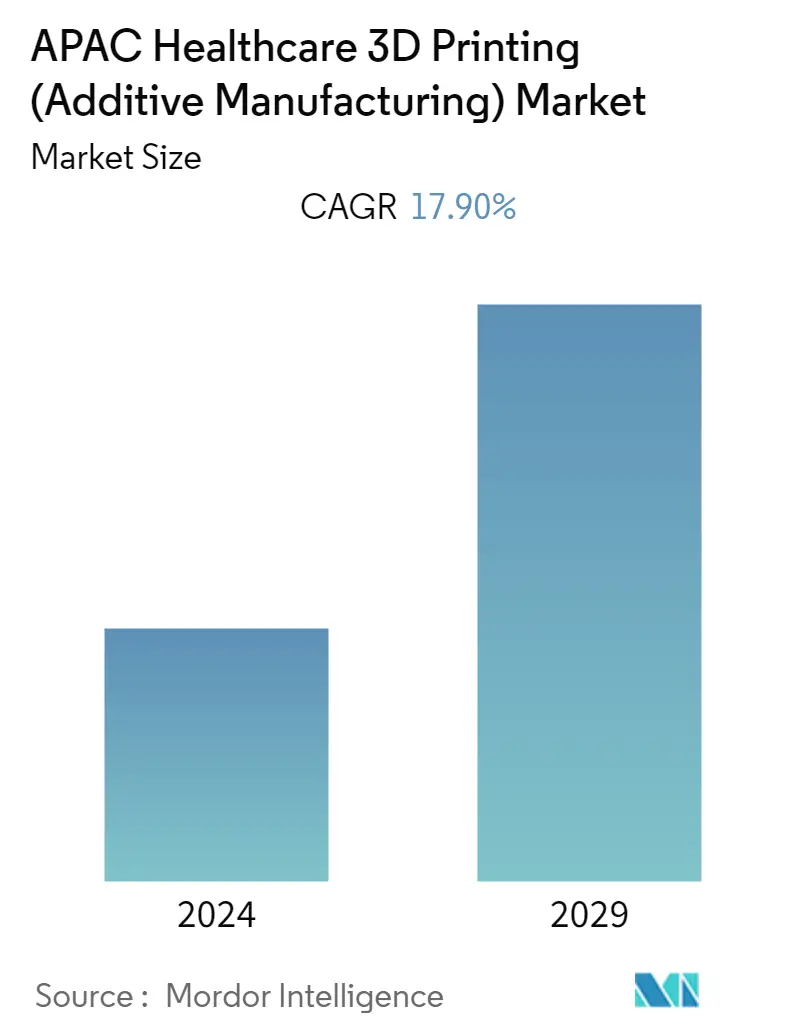Market Size of APAC Healthcare 3D Printing (Additive Manufacturing) Industry

| Study Period | 2019 - 2029 |
| Base Year For Estimation | 2023 |
| Forecast Data Period | 2024 - 2029 |
| Historical Data Period | 2019 - 2022 |
| CAGR | 17.90 % |
| Market Concentration | Medium |
Major Players
*Disclaimer: Major Players sorted in no particular order |
Need a report that reflects how COVID-19 has impacted this market and its growth?
APAC Healthcare 3D Printing Market Analysis
The Asia-Pacific Healthcare 3D Printing (Additive Manufacturing) Market is valued at USD 0.56 billion and is expected to reach USD 1.29 billion by the year 2028, registering a CAGR of 17.9% over the forecast period.
The COVID-19 pandemic had a significant impact on the market studied. According to the National Institute of Health study published in 2020, 3D printing was used extensively during the pandemic and was being utilized to produce vital medical supplies during the crisis. Some vital goods, including ventilator valves, face shields, swabs, oxygen valves, hand sanitizer holders, 3-D lung models, etc., were manufactured via 3D printing during the pandemic. The capacity of 3D printing to print locally using digital designs and reduce supply chain factors has been the key reason for its success. Furthermore, PubMed data published in November 2021 stated that the ability of 3D printing to manufacture/print complicated geometrical patterns locally was the primary reason for its widespread adoption during COVID-19. Therefore, it was observed that the pandemic positively impacted the market studied. However, the market has reached its pre-pandemic nature regarding demand for 3D printing and is expected to witness strong growth in the coming years.
Key factors responsible for the market growth include increasing demand for customized 3D printed parts and instruments and patent expiration. There has been an increase in the demand for customized additive manufacturing as customized structures are more comfortable for patients. For instance, in November 2021, the Australian Government expanded a world-class 3D medical manufacturing facility in Port Melbourne. Minister for Innovation, Medical Research, and the Digital Economy stated that the new investment will enable Melbourne-based 3DMEDiTech to transform its existing facility, supercharging Victoria's advanced medical manufacturing sector and reducing wait times for Victorians needing implants. Hence, with such demand for 3D printing, the market studied is expected to grow strongly in the coming years.
Additionally, data from the Journal of Controlled Release published in February 2021 stated that precision medicine has rapidly overtaken conventional medicine over the past few years. 3D printing, particularly Fused Deposition Modeling (FDM), has been proven to be a potential method for customizing oral medicine administration. The data further stated that additive manufacturing, often known as 3D printing technology, is expected to change how drugs are produced in the coming years. Hence, with the increasing use of 3D printing technology, the market studied is expected to grow significantly over the forecast period.
When patents on 3D printing technologies or specific medical devices expire, other companies can enter the market and manufacture similar products. This increased competition often leads to lower prices for 3D printers, materials, and medical devices, making them more accessible to healthcare providers and driving cost reduction in the industry.
However, additive manufacturing costs are still high, leading to affordability issues, especially in developing and underdeveloped countries. Also, there is a lack of skilled professionals to operate these machinery. These factors have impeded market growth.
